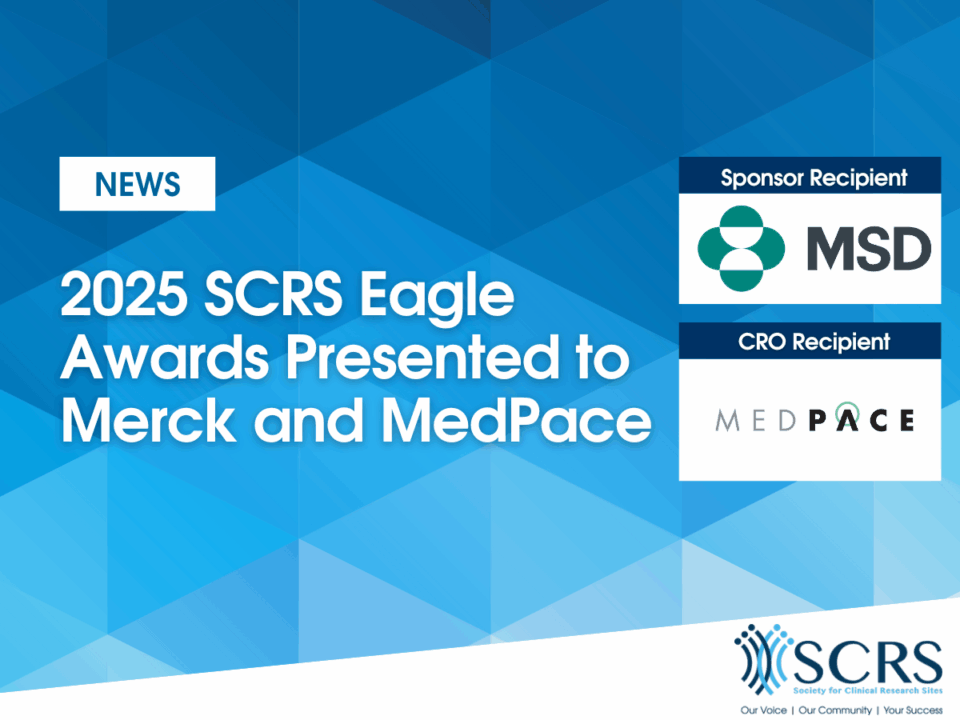SCRS Represents Sites at CDISC Strategy Session
Contact:
Mary D’Rozario
Director of Communication
Society for Clinical Research Sites
919.890.5513
mary.drozario@myscrs.org
FOR IMMEDIATE RELEASE
SCRS Represents Sites at CDISC Strategy Session
Ellicott City, MD, August 24, 2016 – On 02 August Diana Foster, Vice President of Strategy and Development at SCRS, represented the sites at a CDISC Strategy Session moderated by Robert Califf, MD, Commissioner, FDA. The subject of the strategy session was “The Future of Medical Research and the Role of Standards.” Below are selected portions of Ms. Foster’s statement:
Lack of standardization is a direct cause of investigator turnover. This contributes to the escalating cost of conducting clinical trials, but this is just one of the costs. It also narrows the physician investigators available to patients. As we look at a variety of care limitations, from limitations in rural care to limitations in diversity, this narrowing adversely affects patients. For example, currently less than 2% of physician investigators are African American. Efficiently bringing new investigators into research is required to change numbers like this.
The reality is the “one-and-done investigator” problem continues to plague our industry. Over the past decade as many as 40% of Investigators do only one clinical trial and never conduct another industry sponsored clinical trial. SCRS welcome the opportunity to collaborate with the FDA and other organizations to find ways in which standardization can decrease the burden being placed on sites and allow us to ensure patients have the opportunity to participate in clinical trials.
…
To ensure study execution with quality and efficiency a clinical site needs an Investigator with a solid clinical research knowledge coupled with an equally profound understanding of the operational necessities in running a clinical research site. Neither of these can be achieved if we continue to experience Investigator turnover at current levels. It is imperative we resolve the burden being posed to sites, which continues to escalate exponentially as protocols and technology demand more of sites.
Currently the norm for a site is much like “ground hog day” with each new study they execute, sometimes even when it’s from the same sponsor, is a new experience. During a recent panel discussion where our President, Christine Pierre shared the stage with Dr. Eileen Navarro, Lead Medical Officer for the Office of Computational Science at the FDA, it became obvious that what Dr. Navarro shared would aide her department was quite similar to what sites would request. For instance, protocols designed in a standardized fashion with consistent definitions of terminology would aid anyone working with that protocol to easily locate critical information, which would also reduce non-compliance issues identified by the FDA during site inspections.
Through recent work conducted by SCRS we identified that sites may have to use as many as seven different vendors and systems when conducting one study. These systems are typically independent of each other and standardization between them is nonexistent. This fragmentation creates inefficiencies and cost our sites time, which—to repeat—is one of the main reasons they no longer pursue being an Investigator.
We applaud TransCelerate’s effort related to the Common Protocol Template initiative and are further encouraged regarding the CDISC’s collaboration on this initiative in helping to provide standardization within the CPT. As sites are often the end user of products and processes that industry implements, we would also like to acknowledge TransCelerate’s decision to include an SCRS Site Advocacy Group in the Common Protocol Template initiative to ensure the sites’ voice is considered as this project unfolds.
We want to challenge everyone to take a look at current industry norms –each company with their own and specific protocol designs, training logs, screening logs, adverse event forms, terminology definitions, etc. – and request that anything that can be standardized must be standardized. These are not the areas where companies compete – that occurs at the molecular/device level. Training new site personnel should not involve, “On this study from this sponsor this is the way we do it,” but rather “When we do research, this is what we do.”
Not only would a standardized process increase compliance at the site level, it will also allow us more time to spend with the patients and focus in getting the study completed more quickly so the new therapies can get to all patients faster.
Thank you.
###
About SCRS
SCRS is a global trade organization founded in 2012 which represents over 3,000 research sites in 49 countries. SCRS’ mission is to unify the voice of the global clinical research site community for greater site sustainability. SCRS has become an active partner in industry-wide initiatives and dialogues focused on improving the clinical research enterprise. Sites and the companies that sponsor or support the work conducted at clinical research sites will benefit from membership and partnership. Visit MySCRS.org.



